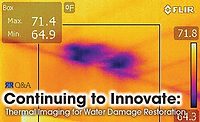Industry Buzz: Thermal Imaging












Editor’s Note: Welcome to a brand new feature section in R&R! Periodically throughout the year, issues will include an “Industry Buzz” section with some quotes and viewpoints about a buzzworthy topic within the restoration and remediation industry.
We’re kicking off this segment by talking about thermal imaging. It can be a fantastic tool for water mitigation jobs by using the camera to detect temperature differences within walls. See a cold spot? That could mean water or moisture – and could help lead you to the problem, saving time and demo.
Here’s what some of your peers had to say:
Daniel Griffiths
Latitude 30A – Destin, Fla.
In the restoration industry since 15, Daniel has worked as a restorer, builder, and estimator.
“I’ve been using a thermal imaging camera for about a year and a half to two years. This tool is a must. It makes finding moisture a lot faster. Once you understand that you are looking for a pattern, and not moisture, the possibilities of a thermal camera are almost endless.
“Since I’ve seen thousands of water damages, read hundreds of engineer reports, and know and understand almost all the components of a home and how most of it works together, I decided to dabble in moisture inspection. I already had a moisture meter from my days in claims adjusting. I talked my wife into letting me drop a pretty penny on a thermal imager, and I’ve started collecting fans, dehus, air scrubbers, an ozone machine, and more.”
Jason Kitts
Rainbow International – Monroe, Mich.
Launched in 2009, Jason owns and operates one of the largest Rainbow franchises in the system covering much of Metro Detroit and south to Toledo.
“We use thermal imaging for a lot. It’s part of our required package for Rainbow International franchises. It doesn’t detect water, it detects the temperature difference. If the water has been there a few weeks and the water is the same temperature as the room, you’re not going to detect it.
“We use it for other things too – like looking at extension cords. Think you blew a breaker? You can trace the cord to see where it’s malfunctioning based on the temperature. You can find where insulation is weak. Thermal imaging cameras also take photos, so you can do before and after pictures. Plus, you can find studs in the wall because the materials will show up different colors.”
“Entry-level guns are $2,000 and $3,000 right now. There are two or three brands out there, price them out and do your research. Start with an entry-level unit, play with it, learn it, and make sure it’s what you want to invest in.”
Troy Holt
Fibertec – Cadillac, Mich.
In business for about a decade, Troy and his small team tackle mitigation and restoration jobs in Northern Michigan. He’s thinking about adding thermal imaging to his services soon.
“We will be adding thermal imaging soon. I looked at it initially, years ago, but the pricing was crazy. Now it’s reasonable, and can save a lot of time on a job. You can see clearly where the water damage is located, and the extent of the damage.”
Looking for a reprint of this article?
From high-res PDFs to custom plaques, order your copy today!











